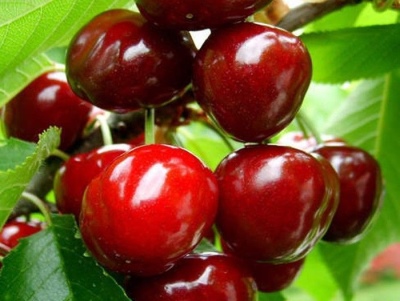
- Authors: T.V. Morozova (All-Russian Research Institute of Horticulture named after I.V. Michurin)
- Barrel type: wood
- Growth type: medium-sized
- Crown: pyramidal medium density
- Escapes: large, dark brown, with few lentils
- Leaves: large, oval, double-crested serration, smooth relief, dark green color, shiny, without pubescence
- Flowers: medium, white, pinkish
- Fruit size: average
- Fruit shape: cordate with a rounded apex, with a depression at the base of the fruit
- Fruit color: dark red
The assortment of cherry varieties is so large that it allows you to choose a tree for each climatic zone. For central and southern Russia, a mid-season variety, Lebedyanskaya, of domestic selection, will be ideal for growing.
Breeding history
Cherry Lebedyanskaya is a fruit and berry crop with a long history, bred in 1990 at the All-Russian Research Institute named after V.I. I. V. Michurin. The author of the variety is the breeder T.V. Morozova. The parent form of Lebedyanskaya cherry is the Vladimirskaya variety. The main task was to create a tree with maximum productivity in the conditions of the Black Earth region, however, after some modifications, cherries began to be cultivated throughout the country.
Description of the variety
Cherry Lebedyanskaya is a medium-sized and fast-growing tree, endowed with a number of features. In a favorable environment, the culture grows up to 3 meters in height. Cherry has a pyramidal crown shape, moderate thickening with dark green foliage with a shiny coating, strong dark brown shoots with a small number of lentils and a developed rod-type root system. Egg-shaped buds grow deviating from the shoot.
Flowering at the tree occurs in the last decade of May and lasts about 12-14 days. During this period, the neat crown of the cherry is covered with rounded white-pinkish flowers that smell good. The ovaries are formed on numerous bouquet branches.
Fruit characteristics
Lebedyanskaya is a medium-fruited variety, characterized by a beautiful heart-shaped fruit with a rounded tip, as well as a dark red color. On average, the berries gain weight up to 4.1 grams. The peel of the cherries is toky, smooth, shiny, without integumentary points. The abdominal suture is poorly expressed.
Cherry fruits are universal - they are eaten fresh, canned, processed into jam, compotes, used in cooking, and frozen. The harvested crop is easily transported and can be stored for some time under appropriate conditions for 15-20 days in a closed container in a refrigerator.
Taste qualities
Cherry attracts not only by its appearance, but also by its excellent taste. The dark red flesh is firm, tender, fleshy and very juicy. The taste is dominated by pleasant sourness, harmoniously combined with sweetness and sugariness. The aroma of the berries is deep. Medium rounded bone is easily separated from the pulp. Cherry pulp contains more than 11% sugars and less than 2% acids.
Ripening and fruiting
This variety is mid-season. The tree begins to bear fruit 4-5 years after planting. The berries are spiced together. Mass ripening of fruits occurs in mid-July. Ripe cherries do not crumble. The duration of the productivity of the cherry tree is 15-20 years.

Yield
The yield indicator of the variety is high. On an industrial scale, you can count on 60-80 centners per hectare. On average, up to 7 kg of ripe cherries are removed from 1 tree per season.
Growing regions
Lebedyanskaya cherries are massively grown in Voronezh, Pavlovsk, Michurinsk and Rostov-on-Don. In addition, cherries are productive in southern Russia, as well as in Ukraine and Belarus.
Self-fertility and the need for pollinators
The cherry tree belongs to the self-fertile class (more than 40%), however, the presence of donor trees on the site can increase the yield by 20-40%. The best pollinating trees are Morozovka, Zhukovskaya, Turgenevka, Vladimirskaya.
Landing
Planting of seedlings is carried out in early spring and autumn. The distance between seedlings should be at least 150-200 cm. Ideal for planting are one / two year old seedlings with a healthy root system.


Growing and caring
For growing cherries, a flat, clean area is chosen - perhaps on a small hill, reliably protected from drafts and gusty winds. As a rule, the tree is planted in the southern part of the garden, where there is a lot of light and heat.
The cherry tree agrotechnology consists of a chain of measures: watering - during flowering periods, pouring fruits, during autumn digging, fertilizing (three times per season), fluffing and mulching the near-stem zone, crown molding, pruning branches (sanitary and rejuvenating), disease prevention, preparation by winter (mulch and covering the trunk with burlap in the northern growing zone).


Disease and pest resistance
Thanks to its good immunity, the tree is not exposed to fungal diseases, and also rarely suffers from coccomycosis, moniliosis and anthracnose.
Requirements for soil and climatic conditions
The tree is comfortable to grow in loamy soils. The soil should be fluffy, breathable, moisture-permeable, fertile, with a low acidity index. The passage of groundwater must be deep, which will prevent stagnation of moisture, harmful to the root system of the tree. Lebedyanskaya cherry is a thermophilic culture that loves moderate moisture, light and air.
































































